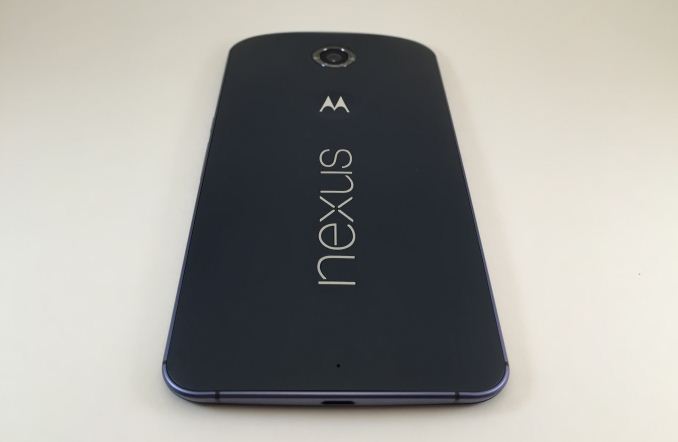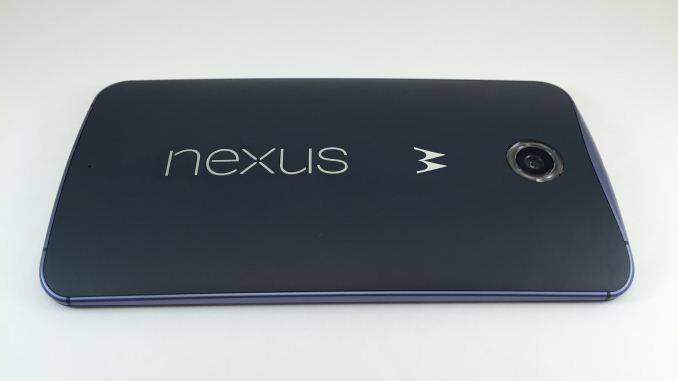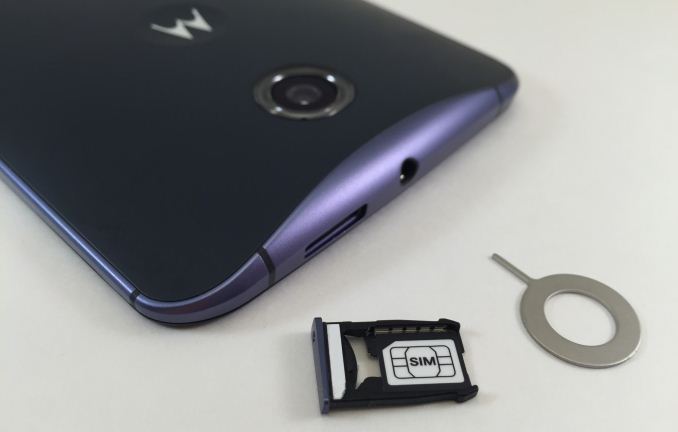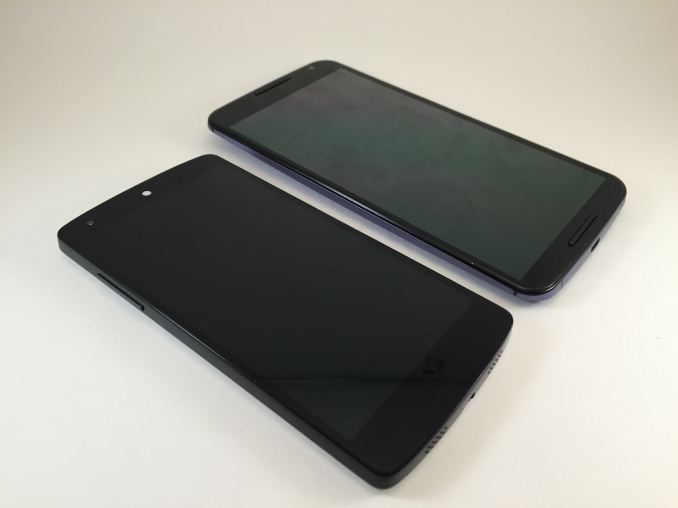The Nexus 6 Review
by Brandon Chester on November 12, 2014 1:00 PM EST
When consumers think of Google's Nexus devices, they think about the promise of receiving the latest updates for Android essentially as soon as they release. They also think about the value proposition that Nexus devices provide by giving good hardware at a price significantly lower than other smartphones. However, this was not always the case. The Nexus One, Nexus S, and Galaxy Nexus were all priced at the same level as other flagship smartphones. It was only with the launch of the Nexus 7 at $199 that we began to see a trend of inexpensive but still high quality devices coming from Google. That hasn't changed at all in the past few weeks. The Nexus 5 and Nexus 7 are both still available, and they still provide a very high quality experience, arguably better than some other smartphones that are both newer and more expensive. But Google's newest devices take aim directly at other flagship devices with both their specs and their prices. At $399 the Nexus 9 positions itself against Apple's iPad Mini 3, while the Nexus 6 at $649 goes up against essentially every other flagship smartphone.
On paper the Nexus 6 doesn't really bring much to the table that sets it high above the competition. This is a consequence of it launching so late into the year, with other companies having already released their new flagship devices. That being said, how a device looks on paper does not translate into how good it is in actual use. There are lots of cases of powerful phones that disappoint, and phones that are weak on paper that end up being surprisingly good. It's still helpful to know what hardware you're dealing with, so I've laid out the specifications of the Nexus 6 below, along with the Nexus 5 as a point of reference.
| Google Nexus 5 | Google Nexus 6 | |
| SoC | 2.26 GHz MSM8974 Snapdragon 800 | 2.7 GHz APQ8084 Snapdragon 805 |
| RAM/NAND | 2 GB LPDDR3, 16/32GB NAND | 3GB LPDDR3, 32/64GB |
| Display | 4.95” 1080p IPS LCD | 5.96” 1440p Super AMOLED |
| Network | 2G / 3G / 4G LTE (Qualcomm MDM9x25 UE Category 4 LTE) | 2G / 3G / 4G LTE (Qualcomm MDM9x25 UE Category 4 LTE) |
| Dimensions | 137.84 x 69.17 x 8.59mm, 130g | 159.26 x 82.98 x 10.06mm, 184g |
| Camera | 8MP Rear Facing, 1/3.2" CMOS size (Sony IMX179), F/2.4. 1.3MP FFC |
13MP Rear Facing, 1/3.06" CMOS size (Sony IMX214), F/2.0. 2.1MP FFC |
| Battery | 2300 mAh (8.74Whr) | 3220 mAh (12.236Whr) |
| OS | Android 5.0 Lollipop | Android 5.0 Lollipop |
| Connectivity | 802.11a/b/g/n/ac + BT 4.0, USB2.0, GPS/GNSS, NFC | 802.11a/b/g/n/ac + BT 4.1, USB2.0, GPS/GNSS, NFC |
| SIM Size | MicroSIM | NanoSIM |
The design of the Nexus 6 is interesting in how it differs from all other Nexus devices, including the Nexus 9. Although the Nexus 9 launched alongside the 6 and is manufactured by HTC, it retains the slightly slanted flat sides and back cover design from the Nexus 5 which is made by LG. The Nexus 6 is made by Motorola, and it follows the style of design that we've seen on their other devices. The back of the device is heavily curved, with a plastic cover that meets a contoured aluminum frame which slopes downward at the top to accommodate the 3.5mm headphone jack and SIM card tray. Both the plastic back and the aluminum sides feel good in the hand, but due to the sheer size of the device your hand tends to rest more on the back cover instead of arching over it, so it doesn't quite have the premium feel of metal devices like the HTC One (M8) and the iPhone 6. Anyone looking to upgrade from the Nexus 5 should also know that the back cover does not have a soft touch finish like the black Nexus 5, and instead has the slightly rougher eggshell feel of the white Nexus 5.
Like always, the back of the device displays the word Nexus in all lowercase characters, and the manufacturing partner's logo which in this case is the slightly indented Motorola logo that appears on all of their other smartphones. Above that is the 13MP camera which is surrounded by a plastic ring that houses the two LED camera flashes. Unlike previous Nexus devices, the camera on the Nexus 6 is aligned in the center rather than being put in one of the upper corners.
The volume rocker and power button on the Nexus 6 are both on the right side of the device, and are placed close to the center of that side so they can be easily used even with the phone being so large. The power button is also textured with a series of small lines so that it can be easily distinguished from the volume rocker. While I had no issues finding the power button, I often found myself pressing the wrong half of the volume rocker which is very slippery and made of a single piece of ceramic. In general I've always preferred having separate volume buttons and the Nexus 6 is no exception.
For some reason one of the parts I found myself really liking about the Nexus 6 is its nanoSIM tray and tray ejector tool. The tray has a much better design than other devices like the iPhone, HTC One, or Nexus 5 which are essentially just a metal frame that you place the SIM into with no mechanism to hold it in. The tray on the Nexus 6 has tiny notches that hold the SIM in place once it has been inserted, so that it doesn't shift or fall out. It's also fitted very well to the bezel of the device, with no misalignment or fitting issues which were both complaints about the SIM tray on early Nexus 5 units. The ejector is also small and fits well on a keychain which I appreciate, as I like to have one with me in case my primary phone's battery dies.
The front of the device is dominated by the large display, with minimal bezel on the top and bottom to include the stereo speakers and front facing camera. Compared to the Nexus 5, the Nexus 6 is thicker and taller, but the curved back and smaller top and bottom bezels help to alleviate that. The increase in width is the most noticeable change from the Nexus 5. The Nexus 6 is a massive smartphone, and its size makes it a firmly two handed device. Of course, that's the point of the device. Having a large display allows you to display more content on the screen and creates a more immersive experience when viewing videos and playing games. It's a larger device than the Nexus 5 because it's meant to offer a different experience. Compared to other phablets like the iPhone 6 Plus and Galaxy Note 4 the Nexus 6 is somewhat more difficult to hold, but not to the extent that I would say it poses an issue.
The comparison to the Nexus 5 is also interesting because Google is still selling the device, and so one could argue that the Nexus 6 is merely an addition to Google's lineup rather than a replacement. While this is a fair point to make, it doesn't address how users who prefer the smaller size of the Nexus 5 are also stuck with an ageing hardware platform. In the end there are always going to be tradeoffs to any device, and a buyer must consider how well a device fits the tasks they want to perform with it.














136 Comments
View All Comments
Brett Howse - Friday, November 14, 2014 - link
It's removed and I was "that reviewer".Apparently wifi scores are the single most critical piece of any smartphone review so this won't happen again.
jaysns - Thursday, November 13, 2014 - link
If you do the storage performance tests with the encryption enabled and disabled on the Nexus 5 you see a huge difference. As the 6 comes with this on by default and does not have a way to manually disable this (as far as I know) I'd love to see a follow up article by Anandtech on this issue and see if they can reproduce this and possibly find a way to disable it on the Nexus 6 and compare results. Based on what I've seen, if I can't disable it, or their storage is really just that slow, it would make a difference on my purchasing decision and possibly help other in the same boat. So please do a follow if you can :)Vizsla1986 - Thursday, November 13, 2014 - link
This particular review is an outlier against all the others, which are basically raves. Some of that is explicable - a lot of sites do pro forma reviews colored by a priori bias - but not all.Since I'm someone who purchased the original Moto X (loved it), upgraded to the Droid Turbo a couple of weeks ago (hated it. Returned it immediately) and then bought a 2nd Gen Moto X, a couple of comments based on actual experience.
1) Everyone needs to look at specs with a jaundiced eye. Sometimes they matter (storage) and sometimes it's contextual (RAM, for example. Depends on how system is used) but most of the time it's about throughput.
2) The Moto X was at least as fast, if not faster on throughput then every phone I compared it to, despite worse specs. A lot of that was display. 720 p is a lot easier on a system than 1080, but also not nearly as good. The 2nd gen. Moto X is *faster* in everyway, IMHO, than the Droid Turbo. I'd say that's also display-related, but the difference here is that the Turbo's screen (same as the Nexus 6) wasn't any better to my eyes than the Moto X 1080. YMMV, but one should carefully check this out. If you can't tell the difference (or much of one) consider the system impact.
2) The Moto X is clearly as fast (actually seems faster) as the Turbo despite an 801 chip compatred to the 805, and different clock speeds. Since I haven't had a chance to handle the Nexus 6, I can't compare, but I would urge anyone considering to pick the the two phones and compare throughput.
3) Clearly the Phablet Nexus 6 is a different experience than a smaller phone. I'm struck, though, that every single review I've read (maybe 6 of them now) has screamed themselves hoarse about how good the Nexus screen is. It's ok to be different, but *that* different? I'd recheck my report if I were the only person criticizing what everyone else thought the best thing about the phone. That's not different. That's idiosyncratic. On a phone this big, display quality is a simple thing to judge. There may be subtleties presenting on measurement, but one should be able at a glance to judge good or bad. I find this review suspect on that ground, never mind the measurements. FWIW, the DROID TURBO was bright enough. So is the Moto X. Why should the Nexus 6 be so different?
4) The price seems eminently reasonable, considering dimensions and specs. I understand why people want to see a cheaper Nexus alternative, but pricing needs to compared against delivered value, not just what one wished for.
5) Battery life. FWIW, I have never, ever, ever never needed to recharge any of the three Motorola phones I've had recently (Moto X Nos. 1 & 2 and the Droid Turbo)before going to bed. Once in a while I've drained to to a 10% remaining, but that would be it. The Turbo had an immense batterry (3900), so that's one explnation, but the 2nd Gen Motox X has only 2400 (from memory. Might be 2200). No problem. Motorola engineers are good at designing systems that get through the day on a charge. The Nexus has what? 3200? That ought to be good enough.
To be fair, everything depends on usage, and I'm not the hardest guy on batteries out there. I watch very little media (so no display drain), mostly calls, text and browsing. Someone else might have a much worse time of it. All I can attest to is my Moto phones have been spectacularly good (for me, anyway).
When I make a major purchase, I always check various vendors and compare thoroughly. If this review were in a purchase matrix I was running, I'd throw it out. It's always been a good policy for me to disregard the high and low bidders (or reviews) unless there was an exceptional circumstance. I don't see one here. I don't trust this review. I can't remember ever saying that about any other AnandTech report.
Graag - Sunday, November 16, 2014 - link
>This particular review is an outlier against all the others, which are basically raves. Some of that is explicable - a lot of sites do pro forma reviews colored by a priori bias - but not all.This is not true at all. Both the arstechnica and Verge reviews also found the Nexus 6 to be "meh".
randomlinh - Friday, November 28, 2014 - link
I dunno, most of the reviews seemed like a mixed bag to me, though leaning positive. But on the screen... AT is one of the only site to give tested numbers. Everyone has been a subjective "it looks great, just a little dim, but probably bright enough". That's not entirely helpful.The Note 4 gets a huge nod from displaymate which seems to mirror the results here: http://www.displaymate.com/Color_Accuracy_ShootOut...
gg555 - Thursday, November 13, 2014 - link
Sigh. No review of the noise cancellation. No mention of whether or not it has the four microphone noise cancellation found in the Moto X. No mention of whether it uses Motorola's CrystalTalk, Qualcomm's Fluence, Audience, or some other noise cancellation.My favorite part of the AnandTech cell phone reviews has totally died. And they were the only one doing it. What a shame.
davidc1 - Saturday, November 15, 2014 - link
Yes, yes, yes! Why no mention of audio quality, call quality, noise cancellation, etc, etc. Very disappointed.lanwellon - Thursday, November 13, 2014 - link
Hi, Brandon, I think you should point out that the reason why the Nexus 6 use the battery so quick is not all because of the bigger screen and more powerful CPU, please be noticed that in all the mobile phones you tested in this table, Nexus 6 is the only one running Android L, and Google enabled FDE (Full-Disk Encryption) function by default from Android 5.0. From my experience using Android 4.0 (Ice Cream Sandwich) FDE function, this can be a reason that cause the battery running down very fast. iPhone also enable FDE function by default, but it seems that Apple optimized it pretty well, so the impact to the battery usage is not that big.ol1bit - Friday, November 14, 2014 - link
There is always a segment of the population that buys Nexus devices because they are factory boxes. This is too make sure people who want a Samsung, HTC, etc. phone are not swayed by the low price to a Nexus device. Goggle doesn't want manufactures to die off, the price of a phone is not how they make their money.murphsp1 - Friday, November 14, 2014 - link
I have owned several Nexus devices and must say that the battery life numbers on this one look terribly disappointing ... and will only get worse over time. I just hope that more manufacturers start to understand that many would happily trade off an extra mm or two in thickness for an extra day of battery life. Now, fingers crossed that the Google Play edition of the Droid Turbo is coming ...